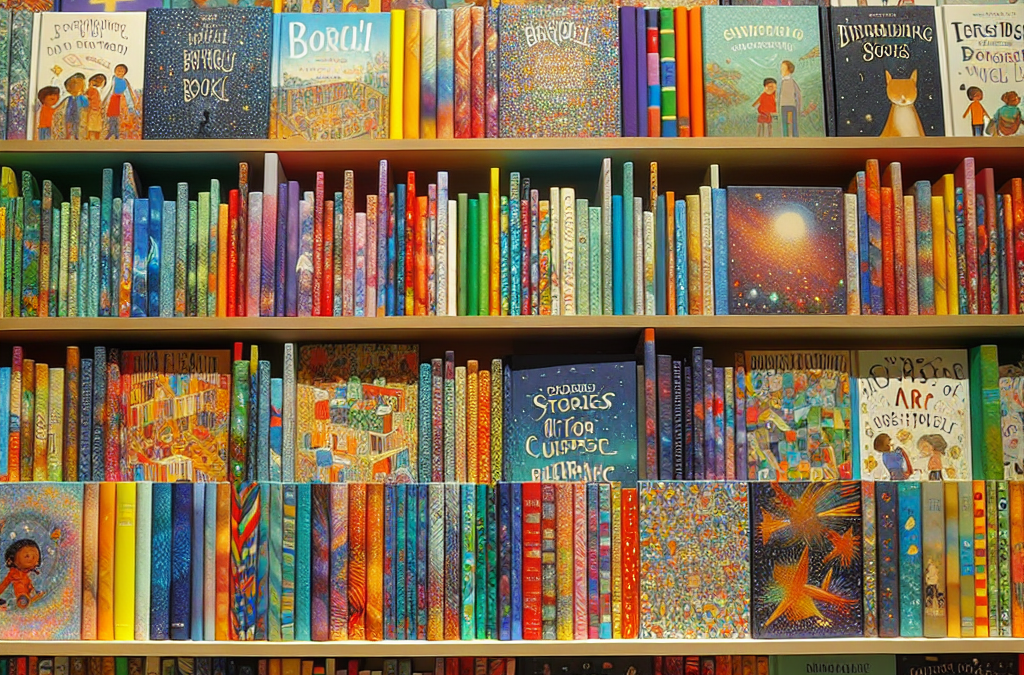So you’re looking to introduce your children to the wonderful world of diversity? Look no further! In this article, we will explore a range of captivating and educational books that celebrate the beauty of our differences. From stories that teach empathy and kindness to tales that promote inclusivity, these books are sure to inspire and engage young minds. Embark on a literary journey that encourages understanding, acceptance, and a celebration of the unique qualities that make us all special.

This image is property of images.pexels.com.
The Importance of Diversity in Children’s Books
Children’s books play a crucial role in shaping young minds and fostering their understanding of the world around them. It is essential that these books reflect the diversity of our society, ensuring that children from all backgrounds can see themselves represented and find solace in knowing that their experiences and identities are valid. The importance of diversity in children’s books goes beyond mere representation; it promotes empathy, breaks down stereotypes, and cultivates a more inclusive and accepting society.
Representation Matters
Representation matters because it allows children to feel seen and valued. When children see characters in books that look like them, have similar experiences, or share their cultural heritage, they feel validated and empowered. It instills a sense of belonging and boosts their self-esteem, fostering a positive sense of identity and self-worth. Conversely, the absence of diverse representation can leave children feeling marginalized, invisible, and questioning the validity of their experiences. It is crucial for children’s books to reflect the rich tapestry of our society and celebrate the diversity that exists within it.
Promotes Empathy and Understanding
One of the remarkable powers of children’s books is their ability to transport readers into the lives of characters who are different from themselves. By introducing children to diverse characters and their stories, these books promote empathy and understanding. Children learn to see the world through the eyes of others, gaining a broader perspective and appreciating the unique challenges and joys that individuals from different backgrounds face. This empathy lays the foundation for tolerance, respect, and compassion, creating a more inclusive and harmonious society.
Breaks Down Stereotypes
Diverse children’s books have the incredible capacity to challenge and dismantle stereotypes, prejudices, and biases. By presenting a range of characters from various backgrounds, these books defy simplistic notions and teach children to see beyond surface-level differences. They emphasize the shared humanity of all individuals, showcasing the common struggles, dreams, and emotions that unite us. Through exposure to diverse narratives, children learn to question stereotypes, break down barriers, and view people as complex individuals rather than one-dimensional caricatures. This not only fosters inclusivity but also encourages critical thinking and a nuanced understanding of the world.
Types of Diversity Covered in Children’s Books
When we discuss diversity in children’s books, it encompasses a wide range of identities and experiences. Here are some key areas of diversity that should be covered to ensure a comprehensive representation:
Race and Ethnicity
Books that explore race and ethnicity are crucial for teaching children about different cultures, traditions, and experiences. They allow children to understand that we live in a multicultural society and that everyone’s story is uniquely valuable.
Gender and Gender Identity
Children’s books that delve into gender and gender identity promote inclusivity and challenge traditional gender norms. These books introduce children to a diverse range of gender identities, allowing them to develop a more nuanced understanding of gender and self-expression.
Religion and Belief Systems
Books that touch upon religion and belief systems help children develop respect and understanding for different faiths. They foster an open-minded approach to religion, highlighting the shared values that underpin various beliefs.
Disability and Special Needs
It is vital for children to encounter characters with disabilities and special needs in books. These stories promote empathy, break down stigmas, and teach children to recognize and appreciate the strengths and resilience of individuals with different abilities.
Socioeconomic Status
Books that explore socioeconomic diversity shed light on the disparities that exist in society. They help children develop empathy for those from different socioeconomic backgrounds, fostering a more inclusive and equitable mindset.
Family Structure
Children’s books that depict diverse family structures challenge the notion of a “typical” family. By showcasing a range of family dynamics, including single-parent families, LGBTQ+ parents, and multigenerational households, these books promote understanding and appreciation for the different ways in which families are formed.
Language and Culture
Books that celebrate different languages and cultures introduce children to the richness and diversity of the world. They promote cultural exchange, understanding, and an appreciation for the various languages and traditions that exist.

This image is property of images.pexels.com.
Diverse Characters in Children’s Literature
To achieve true diversity in children’s literature, it is essential to have diverse characters represented across various roles within a story. This includes:
Protagonists from Different Backgrounds
Having protagonists from diverse backgrounds allows children to see themselves as heroes of their own stories. It empowers them and sends a powerful message that anyone can be the star of their own narrative, regardless of their background.
Supporting Characters and Sidekicks
While protagonists are essential, supporting characters and sidekicks play a crucial role in shaping the narrative and reflecting the diversity of the world. These characters showcase the variety of perspectives and experiences that exist within a story.
Antagonists and Villains
Even villains and antagonists can play a role in promoting diversity. By challenging stereotypes in the portrayal of negative characters, children’s books create opportunities for discussions on prejudice, empathy, and the complexity of human behavior.
Realistic and Well-Rounded Characters
Realistically portraying characters with diverse backgrounds involves depth, complexity, and authenticity. Well-rounded characters showcase the uniqueness of their experiences while also highlighting their universality, making them relatable to readers from all backgrounds.
Multicultural Books and Global Perspectives
Books that explore multiculturalism and global perspectives offer children an opportunity to learn about different cultures, traditions, and societies. These books broaden their horizons, encouraging them to embrace diversity and develop global citizenship. Key themes in multicultural books include:
Exploring Different Cultures
Multicultural books allow children to immerse themselves in the customs, traditions, and daily lives of people from around the world. Through vivid depictions and engaging narratives, children gain a deeper understanding and appreciation for diverse cultures.
Immigration and Integration
Books that tackle the theme of immigration and integration help children understand the challenges and triumphs associated with leaving one’s home and integrating into a new society. They promote empathy, dispel stereotypes, and celebrate the contributions of immigrants.
International Collaborations
Collaborations between authors and illustrators from different countries yield books that offer unique perspectives and insights into diverse cultures. These collaborations provide an opportunity for cultural exchange and encourage children to embrace different perspectives.

This image is property of images.pexels.com.
Books on Gender and Identity
Children’s books that explore gender and identity are instrumental in challenging societal norms and promoting inclusivity. These books encourage children to question stereotypes, embrace individuality, and develop a more nuanced understanding of gender. Key themes include:
Gender Roles and Stereotypes
Books that challenge traditional gender roles and stereotypes allow children to see beyond limiting expectations. They present a world where anyone can pursue their passions and interests, free from the constraints of gender norms.
LGBTQ+ Representation
Books that include LGBTQ+ characters and storylines provide validation and representation to children who identify as part of the LGBTQ+ community. These stories promote acceptance, tolerance, and understanding among all readers.
Non-Binary and Gender-Fluid Characters
Books that introduce non-binary and gender-fluid characters expand children’s understanding of gender diversity. They teach children that gender exists on a spectrum and that there are various ways to express one’s gender identity.
Books on Race and Ethnicity
Books that celebrate racial and ethnic diversity help children develop an appreciation for different cultures, combat racism, and build bridges of understanding. Key themes in these books include:
Celebrating Cultural Heritage
Books that center around cultural heritage allow children to celebrate the rich traditions, language, food, and customs of different racial and ethnic groups. These stories foster pride and respect for diverse backgrounds.
Addressing Racism and Discrimination
Books that tackle the challenging topic of racism and discrimination equip children with the knowledge and tools to challenge prejudice. They encourage discussions on equality, justice, and the importance of standing up against discrimination.
Intersectionality
Books that explore the intersectionality of race with other identities, such as gender, religion, or socioeconomic status, help children develop a more comprehensive understanding of the complexities of people’s lives and experiences.
Religion and Belief Systems in Children’s Books
Children’s books that explore religion and belief systems contribute to building a more inclusive society by fostering understanding and respect for different faiths. Key themes in these books include:
Introducing Different Religions
Books that introduce children to different religions provide a foundation for understanding various beliefs, rituals, and customs. By learning about diverse religions, children develop respect and appreciation for different faith traditions.
Religious Holidays and Traditions
Books that focus on religious holidays and traditions allow children to learn about the significance and celebrations associated with different faiths. They promote cultural exchange, respect for diversity, and a broader understanding of religious practices.
Spirituality and Values
Books that touch on spirituality and values explore themes of compassion, kindness, and empathy, regardless of religious affiliation. These books resonate with children across different backgrounds, emphasizing the importance of these shared values.
Inclusive Books for Children with Disabilities and Special Needs
Inclusive books that portray children with disabilities and special needs challenge ableism and foster empathy and acceptance. Key themes in these books include:
Authentic and Accurate Portrayals
Books that portray disabilities and special needs authentically and accurately contribute to dispelling misconceptions and stereotypes. These books provide young readers with a realistic and compassionate understanding of different abilities.
Disability as Strength and Resilience
Books that highlight the strengths and resilience of individuals with disabilities contribute to destigmatization and promote a positive narrative surrounding disability. These books showcase the unique talents and abilities of individuals with different needs.
Embracing Differences
Inclusive books for children with disabilities and special needs provide an opportunity for all children to learn about and appreciate different abilities. These stories promote inclusivity, friendship, and acceptance.
Books on Socioeconomic Diversity and Inequality
Books that explore socioeconomic diversity and inequality help children understand the realities of income disparity, poverty, and social barriers. Key themes in these books include:
Income Disparity and Poverty
Books that address income disparity and poverty provide children with insight into the challenges faced by individuals and families living in poverty. They foster empathy, encourage gratitude, and inspire actions to create a more equitable society.
Empathy for Different Life Circumstances
Books that shed light on the diverse life circumstances that children may experience due to socioeconomic factors teach empathy and the importance of understanding others’ unique challenges. These stories challenge assumptions and promote kindness towards all.
Breaking Down Social Barriers
Books that confront social barriers and prejudices arising from differences in socioeconomic status encourage children to challenge unfair norms and work towards building a more inclusive society. These narratives inspire children to break down stereotypes and extend a hand of friendship regardless of someone’s background.
Books on Language and Cultural Diversity
Books that celebrate language and cultural diversity provide children with a window into different cultures, languages, and traditions. Key themes in these books include:
Bilingual and Multilingual Characters
Books that feature bilingual and multilingual characters showcase the beauty and value of multiple languages. These stories help children appreciate linguistic diversity and encourage them to embrace their own heritage languages.
Cultural Exchange and Understanding
Books that promote cultural exchange and understanding expose children to the customs, traditions, and distinct ways of life of different cultures. They foster respect, curiosity, and appreciation for diverse cultural backgrounds.
Embracing One’s Heritage
Books that emphasize the importance of embracing one’s heritage inspire children to take pride in their cultural background and identity. These stories promote a sense of belonging and encourage children to honor and share their unique cultural heritage.
In conclusion, the importance of diversity in children’s books cannot be overstated. It is through diverse representation, authentic storytelling, and inclusive narratives that we build a generation of empathetic, open-minded, and inclusive individuals. Children’s books have the power to shape attitudes, challenge stereotypes, and foster a deep appreciation for the richness and diversity of our world. By ensuring that books cover a range of identities and experiences, we can promote a more inclusive and accepting society for all. So let us celebrate the differences and make room on the bookshelves for all stories, for every child deserves to see themselves represented and celebrated.

